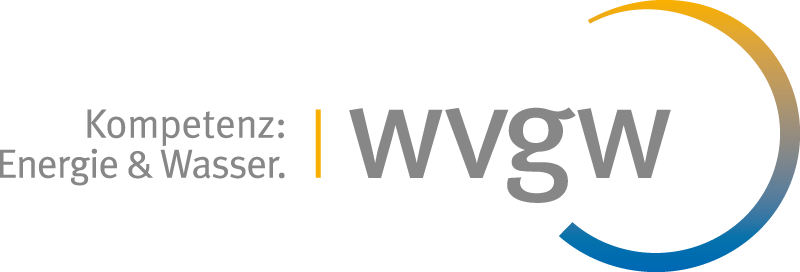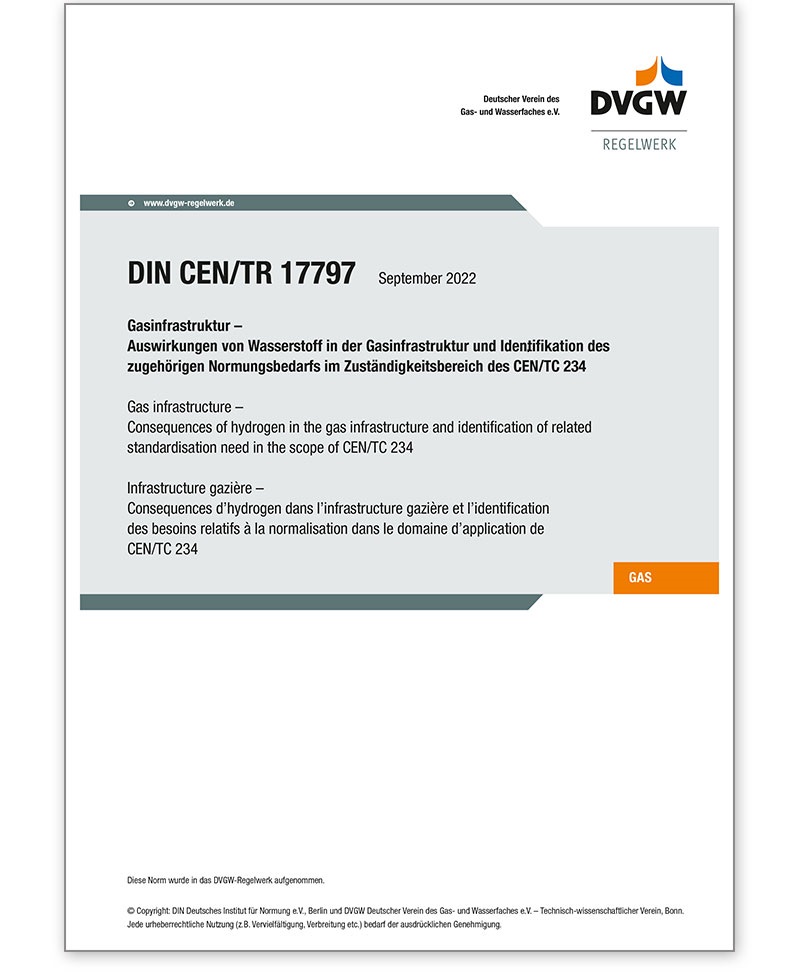DIN CEN/TR 17797 09/2022 - pdf-file -
Gas infrastructure - Consequences of hydrogen in the gas infrastructure and identification of relatedstandardisation need in the scope of CEN/TC 234
- Herausgeber/Verlag: DIN, DVGW
- Format: 131 pages, available as pdf-file only
- Ausgabe: 1st edition 2022
- Verkaufseinheit: 1
- Mindestabnahme: 1
- Artikel-Nr.: 511325
192,50 €*
This document DIN CEN TR 17797 is written in preparation of future standardization and provides guidance on how injection of H2 into the gas infrastructure can impact processes from the input of gas into the on-shore transmission network up to the inlet connection of gas appliances.
European foreword
Introduction
1 Scope
2 Normative references
3 Terms, definitions and abbreviations
3.1 Terms and definitions
3.2 Symbols and abbreviations
4 Executive summary
5 General considerations for the entire gas infrastructure
5.1 Explosion protection and prevention
5.2 N2NG mixtures in contact with materials — Pressure integrity, gas tightness and functionality
5.3 Volume in relation to energy content — consequences for the capacity and function of the gas transportation, underground gas storage and distribution system
6 Technical considerations per topic applicable for the different parts of the gas infrastructure (along chain)
6.1 General
6.2 Gas quality
6.3 Gas compression
6.4 Gas pipelines with MOP over 16 bar — Gas transmission
6.5 Gas pressure control
6.6 Gas metering
6.7 Gas supply systems up to and including 16 bar and pressure testing
6.8 Service lines
6.9 Industrial piping
6.10 Gas pipework for buildings
6.11 Underground gas storage
6.12 Safety management and integrity management
7 Conclusions — H2 suitability of components, materials and procedures used in the gas infrastructure related to identified H2 concentrations
7.1 General
7.2 H2 suitability —Gas quality
7.3 H2 suitability — Gas compressor stations
7.4 H2 suitability — Gas transmission pipelines with MOP over 16 bar
7.5 H2 suitability — Gas pressure control
7.6 H2 suitability — Gas metering
7.7 H2 suitability — Gas pipelines with MOP up to and including 16 bar
7.8 H2 suitability — Service lines ......................................................................................................... 66
7.9 H2 suitability — Industrial piping ................................................................................................. 66
7.10 H2 suitability — Gas pipework for buildings ............................................................................ 67
7.11 H2 suitability — Underground gas storage ............................................................................... 67
8 Revision needs of existing CEN/TC 234 standards and additional deliverables for the H2-readiness of the gas infrastructure
8.1 Action need
8.2 Gas quality — Expected revision of EN 16726:2015+A1:2018
8.3 Gas compression — Expected revision of EN 12583:2014 ................................................... 69
8.4 Pipelines for maximum operating pressure over 16 bar — Expected revisions of EN 1594:2013
8.5 Gas pressure control — Expected revisions of EN 12186:2014 and EN 12279:2000
8.6 Gas measuring systems — Expected revision of EN 1776:2015
8.7 Pipelines for maximum operating pressure up to and including 16 bar — Expected revision of EN 12007 Parts 1 to 4 and EN 12327:2012
8.8 Pressure testing, commissioning and decommissioning procedures — Expected revision of EN 12327:2012
8.9 Welding of steel — Expected revision of EN 12732:2013
8.10 Service lines — Expected revision of EN 12007-5:2014
8.11 Gas installation pipework– Expected revision of FprEN 15001-1:2019 and EN 15001-2:2019
8.12 Gas pipework for buildings — Expected revision of EN 1775
8.13 Underground gas storage– Expected revision of EN 1918-1:2016 to -5:2016
8.14 Safety and Integrity Management System — Expected revision of EN 16348 and EN 15399 by prEN 17649 (merged standard)
Annex A (informative) Any issue coming up during the discussion and outside of the TC 234 scope
Annex B (informative) Safety characteristics of natural gas-hydrogen mixtures
Annex C (informative) Operating principles for gas warning devices [2]
Annex D (informative) Hydrogen pressure versus hydrogen percentage
Annex E (informative) Hydrogen pressure versus hydrogen fugacity
Annex F (informative) An example of the use of an existing gas pipeline for hydrogen gas
Annex G (informative) Use of polyamide (PA-U) in gas piping systems in relation to hydrogen, methane or their mixtures
Annex H (informative) Netbeheer Nederland Study for biomethane and 100 % hydrogen
Annex I (informative) Responsibility of CEN/TC 234 'Gas infrastructure' Working groups for the parts of the gas infrastructure along the chain
Annex J (informative) Symbols and abbreviations
Bibliography

